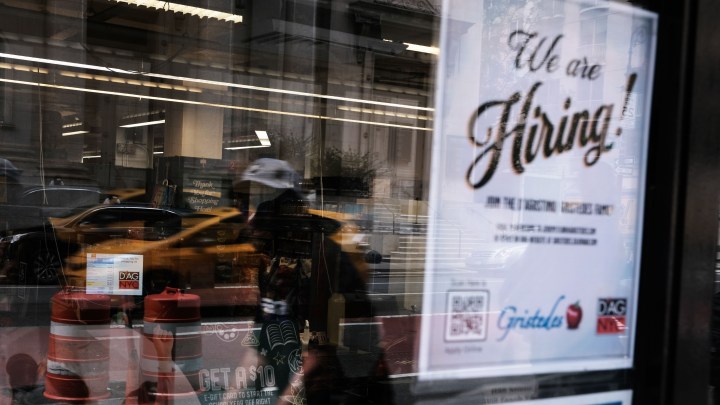
Despite a meh jobs report, high-frequency data paints a bright picture
Despite a meh jobs report, high-frequency data paints a bright picture

A few major forces are impacting and inflecting this economy right now. In no particular order, you’ve got COVID-19 still spreading, delta and omicron included, supply chains still clogged up and complicated, and prices still rising.
Then, there’s the jobs picture: Employers still have lots of them to fill, and workers are still coming off the sidelines of the pandemic to take them.
Simply put, a lot is going on in this economy. But high-frequency data, which can be measured at shorter intervals than standard indicators, can help us understand more about what the economic recovery is looking like.
Help (still) wanted
Every month since June, employers have posted more than 10 million job openings, according to the Bureau of Labor Statistics.
Online job site Indeed — which is a Marketplace underwriter — tracks openings in near-real time. Job postings are running more than 50% above pre-pandemic levels, said economist AnnElizabeth Konkel.
“We have human resource job postings — they are up 119% compared to their pre-pandemic baseline. That is a huge number and shows that employers have a really strong appetite to hire people who will help hire others for their businesses,” she said.
Once hired, workers aren’t very likely to get laid off and know from friends and family that layoffs are down, according to John Leer at the polling firm Morning Consult.
“And as fewer and fewer people around them lose their jobs, that helps people feel more secure about their economic future,” he said.
People returning to work after long bouts of pandemic unemployment may not feel so secure yet. That’s especially true of jobs in the service sector, like delivery drivers, nail-salon employees, waiters and short-order cooks.
Workloads and job security
The November jobs report, released last week, had a pretty mediocre, under-expectations number for job creation — just over 200,000.
But other indicators paint quite a different picture of what’s going on. Employers may not have added many employees in November, but they sure are adding a lot of work shifts for their existing employees and anyone they can hire, according to Dave Gilbertson at payroll processor UKG — a Marketplace underwriter.
“We’re seeing a lot more people work overtime these days, as employers are having a harder and harder time recruiting and hiring on new employees,” Gilbertson said.
That’s driving a strong sense of job security, according to Chris Jackson at public-opinion firm Ipsos. That’s not true for everyone, though.
“A lot of the insecurity, a lot of worry about losing jobs really still remains concentrated on lower-income people who are more affected by things like COVID shutdowns,” he said.
Upper-income professionals are feeling much more confident that their jobs are secure, no matter what the pandemic throws at us next.
A boost in wages and bonuses
At this point, pretty much everyone knows that prices have been increasing — up around 6% year over year. Wages are going up too, though not quite as much. It was 4.8% last month.
Workers aren’t just getting raises, as employers scramble to keep their people from jumping ship. More and more jobs posted on Indeed are offering signing bonuses, Konkel said.
“I have seen some that are just thousands of dollars and, I mean, that’s substantial regardless of what sector you’re in,” she said.
The reopening of schools and day care centers is also bringing people back to work, per Morning Consult’s Leer. But they aren’t necessarily building back their savings.
“You know, we’ve got a lot of rising prices that are going to hit people at the lower end of the income spectrum because it’s hitting a lot of their nondiscretionary spend, like gas and groceries,” he said.
The reserves people saved up from pandemic relief checks and jobless benefits are dwindling, Leer added.
There’s a lot happening in the world. Through it all, Marketplace is here for you.
You rely on Marketplace to break down the world’s events and tell you how it affects you in a fact-based, approachable way. We rely on your financial support to keep making that possible.
Your donation today powers the independent journalism that you rely on. For just $5/month, you can help sustain Marketplace so we can keep reporting on the things that matter to you.











